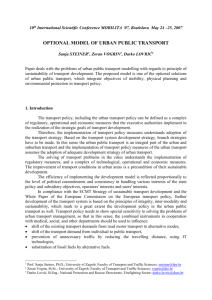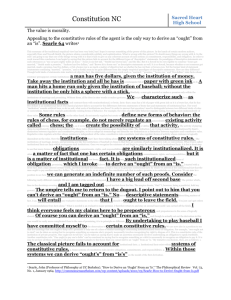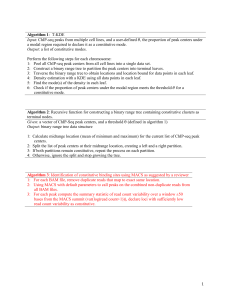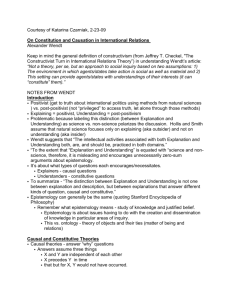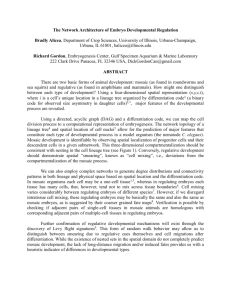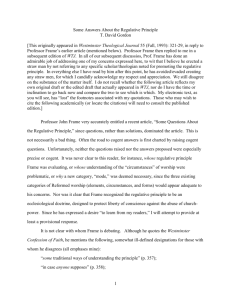Constitutive Rule Systems
advertisement
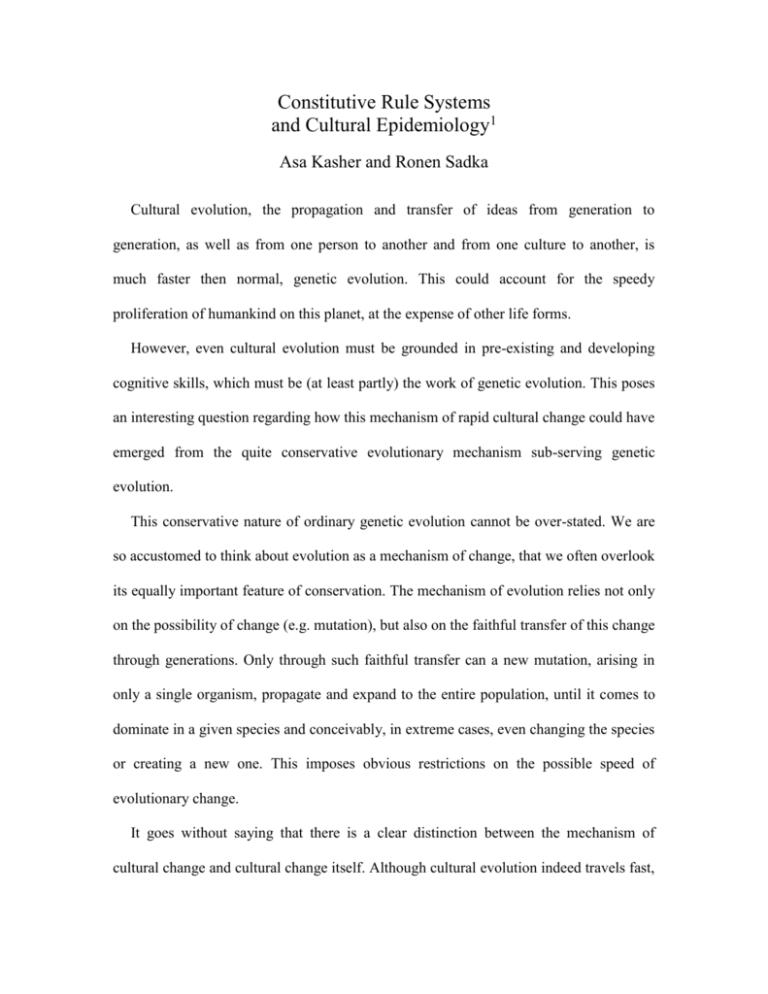
Constitutive Rule Systems and Cultural Epidemiology1 Asa Kasher and Ronen Sadka Cultural evolution, the propagation and transfer of ideas from generation to generation, as well as from one person to another and from one culture to another, is much faster then normal, genetic evolution. This could account for the speedy proliferation of humankind on this planet, at the expense of other life forms. However, even cultural evolution must be grounded in pre-existing and developing cognitive skills, which must be (at least partly) the work of genetic evolution. This poses an interesting question regarding how this mechanism of rapid cultural change could have emerged from the quite conservative evolutionary mechanism sub-serving genetic evolution. This conservative nature of ordinary genetic evolution cannot be over-stated. We are so accustomed to think about evolution as a mechanism of change, that we often overlook its equally important feature of conservation. The mechanism of evolution relies not only on the possibility of change (e.g. mutation), but also on the faithful transfer of this change through generations. Only through such faithful transfer can a new mutation, arising in only a single organism, propagate and expand to the entire population, until it comes to dominate in a given species and conceivably, in extreme cases, even changing the species or creating a new one. This imposes obvious restrictions on the possible speed of evolutionary change. It goes without saying that there is a clear distinction between the mechanism of cultural change and cultural change itself. Although cultural evolution indeed travels fast, the mechanism responsible for it could be quite conservative. To mention a well-known example, the mechanism for the propagation of ideas could be a mechanism for the (nonarbitrary) fixation of belief. This mechanism makes use of all the knowledge from the various perceptual modules available on the subject, drawing on memory and other sources (e.g. the verbal exchange of knowledge with other people) to build up, or more often, to revise a theory of the world. Such a theory would probably be better and certainly more informed than any modular mechanism which takes only part of the available knowledge into consideration (Fodor, 1990). Now, such a mechanism for the fixation of belief is relatively fixed through generations (probably for millions of years), while the theories it handles are rapidly changing. Cultural evolution is much more rapid than genetic evolution just because it is based on a quite different mechanism. However, our emphasis on the conservative nature of genetic evolution is not meant to undermine this difference between genetic evolution and cultural evolution. Rather, it is meant to raise the question of how such a mechanism for the fixation of belief, or any central mechanism of another sort, could have evolved from the arguably modular mechanism that preceded it2. It seems reasonable to assume that every mechanism of cultural change must, whether directly or indirectly, be based on a mechanism (possibly the belief fixation mechanism) that evolved in an ordinary genetic evolution. What is so interesting about cultural change from an evolutionary point of view is not that it is rapid, given a mechanism that allows it to be so, but how such a mechanism could have risen in the first place from mechanisms that could not allow it. This is exactly where the conservative nature of evolution seems important. For, if evolution moves only in a gradual manner, taking incremental steps, we must account for the emergence of a system that allows cultural evolution on the basis of small adaptations of previously existing mechanisms3. How, then, could a mechanism that allows cultural change emerge from mechanisms that did not allow it? One very interesting and influential idea has been proposed by Dan Sperber (Sperber, 1994). Sperber opined that the evolution of ideas might be grounded in events of a typical kind: a modular cognitive mechanism is invaded by an input it was not (evolutionarily) designed to process. Sperber then went on to suggest that such cognitive mechanisms might exist even at the level of micro-modules, each of them responsible for the processing of just one concept. Such a micro-module would normally have as input several perceptual features that taken together would signal the existence of a certain object in the organism’s environment. In response it would issue an order for an appropriate action of the organism. Thus, a certain micro-module possessed by a certain primitive organism (the “org” as Sperber has dubbed it) would signal the existence of an elephant, by noting the noise and the vibrations elephants cause, together with some other relevant information about danger, such as danger signals provided by other orgs. It would then combine those bits of information and transfer them into an inference-making mechanism designed to order flight when there are elephants around and staying put when there is not enough evidence of danger. Under different circumstances, for example, when there are no elephants but only hippopotamuses abound, the very same mechanism would signal the existence of the latter and the response of the org would eventually be identical. The possibility of such a shift in what the micro-module represents is evident once we acknowledge the possibility of an error or misrepresentation in a place where orgs would encounter both elephants and hippopotamuses in their environment. Once the possibility of such an error is granted, it is easily conceivable how in the absence of elephants, the org could indeed use the micro-module to detect hippos. (This line of argument was adapted from Burge’s work (Burge, 1987)). The mechanism of cultural evolution now needs only one additional step, and Sperber suggests how it was taken: the option for the activation of a certain mechanism by a non-related input should not be limited only to errors and misrepresentations. Applying a mechanism designed for a certain purpose to a different one will naturally yield a different output, and this opens the way for cultural evolution to proceed (Sperber, 1994). This idea, that cultural evolution could proceed by the invasion of a new input into a pre-existing mechanism, is interesting and fruitful, because it offers an explanation of how cultural evolution could begin with only a slight change in an already existing mechanism. However, we think this idea should be disentangled from the massive modularity hypothesis that Sperber puts forward in the same paper. We find the idea of massive modularity highly problematic from a conceptual point of view and improbable from a cost-effectiveness point of view4. Most specifically we wish to stress that the formation and initiation of new micro-modules in Sperber’s scheme is dependent on contextual features, that can not be predetermined (and hence could not be modular). Any new micro-module is probably initiated only following the detection of a substantial change in what the other modules and micro-modules come to represent. But whatever counts as a substantial change is not a modular feature. It has to take into account a great deal of circumstantial evidence, and consequently it is a much wider mechanism for the fixation of belief. But if this is so, it is not clear why we need massive modularity in the first place. It seems more reasonable to suggest that the same mechanism that can determine the initiation of a new micro-module or module could itself fix the representations and handle them. Fortunately, Sperber’s idea of cultural epidemiology can be applied not only to modular systems but also to any other sort of rule-governed activity. It is our major point here that the leap from natural cognitive systems to cultural ones takes place in the realm of rule systems that govern human activity. We propose to account for cultural evolution by applying to it the well-known distinction between regulative and constitutive rule systems (Searle, 1969). A regulative rule system, on the one hand, is a system of rules designed to regulate an already existing activity. This nature of activity, and moreover its point, are external to the system itself. The relation of such a rule system to its point is that of means to an end. Hence, the point of a regulative rule system is logically prior to the rule system itself. A constitutive rule system, on the other hand, has its point defined internally. The point does not exist independently of the rule system itself, and thus the rule system logically precedes its point. The traffic rule system is a classic example of a regulative rule system, while the chess rule system is a common example of a constitutive rule system. You would be able to know how to drive your car, even if there were no traffic rules, but you would not be able to win a game of chess or even play it at all without being aware of and following the rules of the game. Our interaction with the environment, which is the basis of any evolutionary consideration, is regulative. Its main purpose is the organism’s survival. If the actual domain of the rule system, to use Sperber’s terminology, does not reside with its proper domain then it would not have been selected for. Regulative rule systems comprise our most elementary behavioral repertoire. However, once such a system exists, it could be used for other purposes as well. To adapt Sperber’s idea to systems of rules, when cultural evolution begins, the process might involve the invasion of input to an already existing rule system, thus depriving it of its original regulative role. The rule system is now defined internally: there is no external end to oblige it. The rule system is now logically prior to its end: the end does not exist without it. Hence, we must render it constitutive. Cultural change, we propose, should be viewed as a transition from a regulative to a constitutive rule system. This might be what has happened with the family institution. Families arose, one can imagine, to accommodate human children’s need for a long upbringing period. The offspring’s had a better chance of survival if their mother and father worked together to provide for their needs. Rules were then added to further regulate this form of life, forbidding incest on the one hand, and fostering within-family altruism on the other5. These rules defined the members of the family, the relations amongst them, and what is allowed or demanded from each of the family members. This same set of rules had come to define and govern within-family relations, and thus to constitute our cultural idea of a family, which still holds true even in families where the original regulative use no longer exists. These include, for example, adopted children, stepparents and foster families. For such cases, the family rule system could only be regarded as constitutive: it defines what it is to be a family. Indeed, this constitutive feature of the family concept in our culture should not be limited for only these particular cases. It is illuminating for the role of families in general. This is not to claim, of course, that there is no external end people can pursue by acting within the framework of a family institution. The fact that a system of rules is constitutive does not mean people could not pursue an external end by following its rules, even though such a pursuit is, indeed, not required by the rules. You can feel pleasure in playing chess and that might be your only incentive for playing it, but it is neither a necessary nor a sufficient condition for you to be regarded as playing chess. What defines playing chess is the system of rules of the game. The same holds for the family institution6. What was once a system to regulate reproductive success, is now an element of a cultural system, defined and governed by a constitutive system of rules. Similarly, we might regard some rituals, such as changing of the guards at Buckingham Palace, as another example of such a transition. What seems now to be a ceremonial activity most probably had a regulative nature in old times. The king or queen had to be protected, and protection would be best achieved by a loyal group of royal guards. Those guards had to wear a special uniform to distinguish them from other troops, and in order to prevent the possibility that the king or the queen would be left unguarded, rules were devised to administer the changing of the guards. These rules specified where and when changing of the guards should take place, who can (and indeed should) take part in it, how they should be dressed, and the exact manner in which the change should be effectively performed. All of these rules served to the external end of Royal protection. Nowadays, however, it is quite clear that the ceremony is deprived of any such regulative use. Protection is the objective of other units. The changing of the guards is a ceremony. Its performance has meaning but it does not have an external end. The uniform and the march have nothing to do with effective protection of the Queen. Consequently, the ceremony is now defined by its own terms. What was once a regulative rule system is now a constitutive rule system that defines and governs the changing of the guards. This way of viewing cultural change might also help to explain the adaptive value of culture. This is an important and problematic feature of cultural evolution that has to be explained whenever a theory is put forward of the mechanisms of cultural evolution. It is usually difficult to understand the adaptive advantage of cultural systems, but the approach of the present paper seems to provide us with a general solution. Viewing cultural change as a transition from regulative to constitutive systems of rules suggests that the latter might inherit their adaptive values from the former. A regulative system might possess, apart from the regulative system of rules and a mechanism for their application, also some feature to distinguish a successful from an unsuccessful application of the system. Gopnik proposes that explanation serves as a symptom for the success of theories, exactly as orgasm might serve to signal out the success of the reproductive action (Gopnik, 1996). If Gopnik is right, then regulative systems signal success with the ability to account for that success in terms of an explanation or in some other natural form. Such success markers might linger on in constitutive systems, allowing them to be sustained in our mental repertoire, even though their original regulative use is now absent. This is why we find explanation to be so appealing in cultural settings, even though constitutive rule systems do not require it. Thus, we might find much pleasure in reading how Sherlock Holmes puts the pieces of an intriguing case together, though it possesses no value for us apart from the joy of reading. Myth, to take another example, according to common depictions of ancient cultures, was used to explain away disturbing irregularities in the world. The ancients used myth as their best theory of the world and consequently it affected their actions. Although we have come to reject the regulative power of those stories in controlling our behavior or that of the natural world, it has retained some of its explanatory power, if only for our enjoyment. In reading Greek mythology stories we do not replace the god of rain by a scientific theory of rain but rather go on using the constitutive elements of the myth: the power of gods, their relations with each other, their motivation and actions, etc. When we do so we take them to be the defining features of the story and accept them as such. There is no resort to their previous regulative use. However, within the limited world of the story, we accept those tenets as explanatory. Moreover, we would accept only explanations that would be consistent with these rules. We would not accept, for example, for a human to have divine powers, were they not bestowed on him by one of the gods. If explanation did evolve, as Gopnik argues, to signal the success of theories, and thus to motivate the search for theories, then the transition from regulative to constitutive systems makes a parasitic use of this feature. This is not, however, a special feature of explanations and theories, as Gopnik argues convincingly. The same could be said about having an orgasm while being on the pill. A similar link between a regulative rule system and a constitutive rule system that preceded it and that does not involve explanation might be suggested in the case of beauty. Here too, the connection is based on some symptoms of success that were formerly a part of the regulative rule system. Beauty has long been regarded as characterizing works of art (within certain periods and traditions). However, beauty can be regarded as a by-product of successful activity within the framework of a distinct regulative system. On a par with explanation, beauty might have served as a sign of the success of a regulative system and not its primary goal. Intuitively, we tend to regard as beautiful, figures of certain kinds bearing such features as symmetry and closure, which are signs that a certain fruit or vegetable is intact, and therefore could be regarded as fresh food (compared to a spoiled one). Thus, some regulative system of rules for telling fresh food from spoiled food, by evaluation of properties such as symmetry and closure, can be assumed to have served as the birthplace of the sense of beauty, assuming it accompanied successful evaluations of shapes. Of course, such a system (which might be modular) is not infallible, so a regulative rule system that could take into account other factors as well could have been added on top of it to improve performance. Such a system would clearly be cognitively penetrable, as the information that could bear on the question is not specified in advance. As time passed the importance of this system for its original regulative use had largely diminished. However, it came to play a role in cultural settings. Relying still on the former system, beauty in the original sense continued to be a sign of success of the latter system too. Take architecture, for example. We can imagine archaic humans (or even more archaic primates) looking for shelter. The shelter had to have certain features: it had to provide shelter for everyone in the party, it had to offer protection from predators (therefore it had to be a good hiding place) and from the storm, it should not collapse on your head, and so forth. This could have led to the formation of a system of regulative rules that may have evolved in this organism. Those who had it enjoyed a better chance of survival, and so they evolved to be our human ancestors. Symmetry and closure could have been signs for the existence of the demands of the rule system. Consequently, when architecture began, these same old requirements continued to play an important role in the way good or even beautiful buildings were conceived. These features still play an important role in the way we conceive of architecture today, on certain occasions, even though new technology is gradually freeing architecture of at least some of these constraints. Thus, architecture still uses the old regulative system as a basis for appreciation, on at least some occasions, while gradually freeing itself from it. Some of the other arts, on the other hand, have completed the transition from a regulative to a constitutive rule system7. As suggested previously, regulative rule systems were based on primitive modular systems, but were themselves cognitively penetrable. With the passing of generations, there was an invasion of input from other sources. Cultural transmission becomes gradually the main ingredient, and the importance of the primitive modular system largely diminishes, at least for those rule systems. In effect, art has become a complex of inter-related practices, brought into existence and governed by constitutive rule systems, which define the means, ends, roles and products of the practices they constitute (Kasher, 1990; Graves, 1997). These rules define the art world as a framework for presentation of works of art, created by artists, to an art-world public. They also tell us when to consider a person an artist, a group of people as public, and an artifact as a work of art. These definitions of ‘work of art’, ‘artist’ and ‘art world public’ are inter-related (“inflected” in terms of the institutional theory of art; cf. Dickie, 1984.) They presuppose and support one another. This inflected nature is typical of constitutive rule systems. The rules of chess, for example, define the game and govern its playing. The rules define the opponent roles, the pieces, the board, the starting point, the end positions, etc. They govern the moves and specify the point of the game. All are introduced as a whole, by an interlocking system of definitions. There is no point in introducing one ahead of the others. Any change of the rules would not count as a different form of playing chess, but rather a different game altogether. Similarly, art in general and arts in particular are constituted by inter-connected systems of rules. You cannot maintain the nature of a particular art world system, while ignoring one of its basic rules (Kasher, 1990). Thus, the constitutive rule system underlying art, or an art, departed completely from its original use. Having its end now defined internally, and devoid of the any regulatory use, art could now free itself also from its connection to the primitive (possibly modular) system it used as its signal of successes. This does not mean that it has no sign of success at all: as art is now defined by the constitutive cultural system, interpretation (based on the requirements of the rule system; see Graves, 1997) is now an important ingredient in the evaluation of a work of art. Interpretation is, of course, a feature of theories, and theories signal success, as we have already seen, by the ability to provide an explanation. Of course, works of art singled out this way as worthy of appreciation may differ from the ones to which the old regulative system would have chosen to attach a status of beauty. Consequently, we might use today terms like “beautiful” and “art” for things that are very remote from their original use. Admittedly, such a process is not an easy one. It is slow and demanding, and is continuously subject to relapses. As the example of architecture demonstrates, even when technology exists to render the regulative use of the rule system less important, a total abandonment of the regulative system does not follow immediately. A shred of regulative use suffices to prevent our completing the transition. This may be due to the conservative feature that must be important for any evolutionary change to take place. In fact, we can see that even in other forms of art, where the transition was completed, there is still a substantial strength to features that were a part of its regulative past. This is not surprising, as most of the rules in the now constitutive system of rules originated in the regulative rule system, and as change is gradual and painstaking. In the case of art in general as well as some of the particular arts, however, the transition is complete. The art system of rules, like any other constitutive rule system, has its end defined internally. This reflects the completion of the transition. Any rule that might have remained from what was once a regulative rule system is now part of a constitutive rule system, and should be regarded as such. Any reference to its past may be interesting from evolutionary and historical perspectives, but is irrelevant to its present role. There is a tendency to confuse the two, and this should be avoided. Even if some of the rules may have survived the transition, their function as a part of a constitutive rule system is now different. The rule systems underlying different arts do not only relate meaning to a work of art, but they also constitute the fact that they can mean anything at all. In conclusion, we have proposed that cultural evolution is based on a transition from regulative rule systems, linked to primitive cognitive systems and designed to correct errors that could arise in those primitive systems, to constitutive system that depart from the primary regulative objective. The process must be cognitively penetrable, hence nonmodular, for it involves processes that are based on belief fixation. Cultural epidemiology is thus achieved by the recruitment of regulative rule systems for other purposes. This process is slow and demanding, and therefore not very widespread in nature. Reference Burge, T. (1987) Marr's Theory of Vision. In: Modularity in Knowledge Representation and Natural-Language Understanding, edited by J.L. Garfield, MIT Press, Cambridge, Massachusetts & London, England, pp. 365-381. Cosmides, L. & Tooby, J. (1994) Origins of domain specificity: The evolution of functional organization. In: Mapping the Mind: Domain specificity in cognition and culture, edited by L.A. Hirschfeld and S.A. Gelman, Cambridge University Press, Cambridge, pp. 85-116. Dickie, G. (1984) The Art Circle: A theory of art, Haven Publications, New York. Eldredge, N. (1995) Reinventing Darwin: The Great Debate at the High Table of Evolutionary Theory, John Wiley, New York. Fodor, J.A. (1987) Modules, frames, fridgeons, sleeping dogs, and the music of the spheres. In: Modularity in Knowledge Representation and Natural-Language Understanding, edited by J.L. Garfield, MIT Press, Cambridge, Massachusetts & London, England, pp. 25-36. Fodor, J.A. (1990) Why should the mind be modular? In: A Theory of Content and Other Essays, MIT Press, Cambridge, Massachusetts & London, England, pp. 207-230. Gopnik, A. (1996) The scientist as child. Philosophy of Science 63, 485-514. Gould, S.J. and Lewontin, R.C. (1979) The Spandrels of San-Marco and the Panglossian Paradigm: a critique of the adaptionist program. Proc.R.Soc.Lond. B 205, pp. 581-598. Graves, D. (1997) The institutional theory of art: A survey. Philosophia (Philosophical Quarterly of Israel) 25, pp. 51-65. Kasher, A. (1990) On art circularity: Logical notes on the institutional theory of art. In: Du Vrai, Du Beau, Du Bien: Etudes Philosophiques Presentees a Evanghelos Moutsopoulos, Librairie Philosophique J. Vrin., Paris, pp. 184-191. Marr, D. (1982) Vision, W. H. Freeman, San Francisco. Mithen, S. (1996) The Prehistory of the Mind, Thames and Hudson, London. Searle, J.R. (1969) Speech Acts: An Essay in the Philosophy of Language, Cambridge University Press, Cambridge. Sperber, D. (1994) The modularity of thought and the epidemiology of representations. In: Mapping the Mind: Domain Specificity in Cognition and Culture, edited by L.A. Hirschfeld and S.A. Gelman, Cambridge University Press, Cambridge, pp. 39-67. Tel-Aviv University Tel-Aviv 69978 Israel asakasher@hotmail.com 1 2 We are grateful to Dan Sperber for helpful comments on a previous version of the present paper. The fact that perceptual mechanisms preceded mechanisms of reasoning and of belief fixation is, we take it, beyond dispute. There might be objections as for the modularity of these mechanisms. This, however, is not important for our present argument. Probably even those who object to the modularity thesis would have to account for the difference between perceptual mechanisms and mechanisms of reasoning or of belief fixation. This would compel them to explain how the latter evolved from the former. 3 This is not to say that evolution must go ahead in a specified direction, or that adaptations could not build on spandrels and the like (Gould & Lewontin, 1979, see also Eldredge, 1995 for an extended discussion on the evolutionary debate on the matter), but even spandrels built on some prior existing mechanism, though the way they build upon it may not be as obvious. 4 Our rejection of the massive modularity hypothesis would be dealt with in length in another paper. In a nutshell, our objections to this hypothesis are, first, that the mechanisms it postulates are too expensive. Secondly, that it is not clear how long the search for an appropriate micro-module to handle a given representation should take place before the initiation of a new micro-module, Sperber’s vehicle for evolutionary epidemiology, should be initiated. Thirdly, that the information that must be available for the decision to initiate a new micro-module is in itself context sensitive and therefore must rely on a more general belief fixation mechanism, one that undermines the need for massive modularity in the first place. 5 These two kinds of rules harbor an inherent tension between them (Cosmides & Tooby, 1994). This could be vividly demonstrated by the extent of inter-family marriages allowed in different cultures. In some tribal cultures, for example, it is customary for cousins to marry, although, arguably, this is not the best genetic strategy. This custom probably reflects the scarcity of resources in those tribal communities, which rises the need to keep those resources in the family (and lends better chances for survival for those who do so). Cosmides and Tooby seem to suggest that the apparent tension between the two kinds of rules implies that they are handled by distinct modules. The above mentioned examples, show, however, that they are interrelated, and thus can not be accounted for by a single mechanism, either modular or general. 6 see (Kasher, 1990). 7 See (Graves, 1997).

